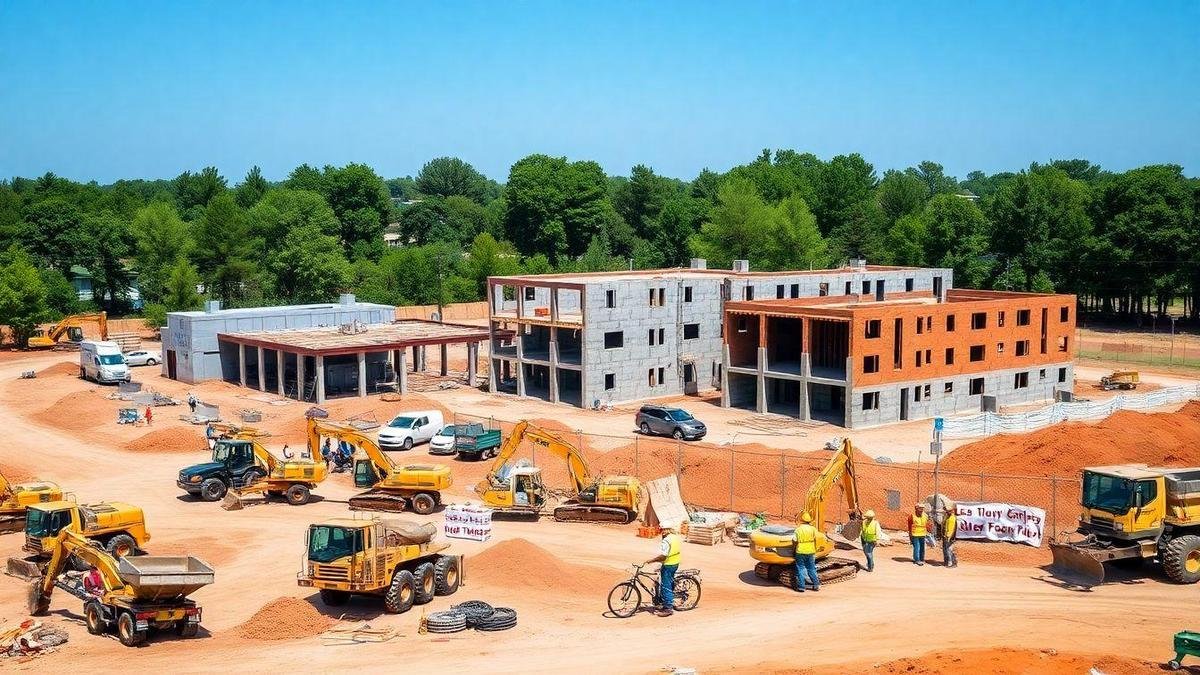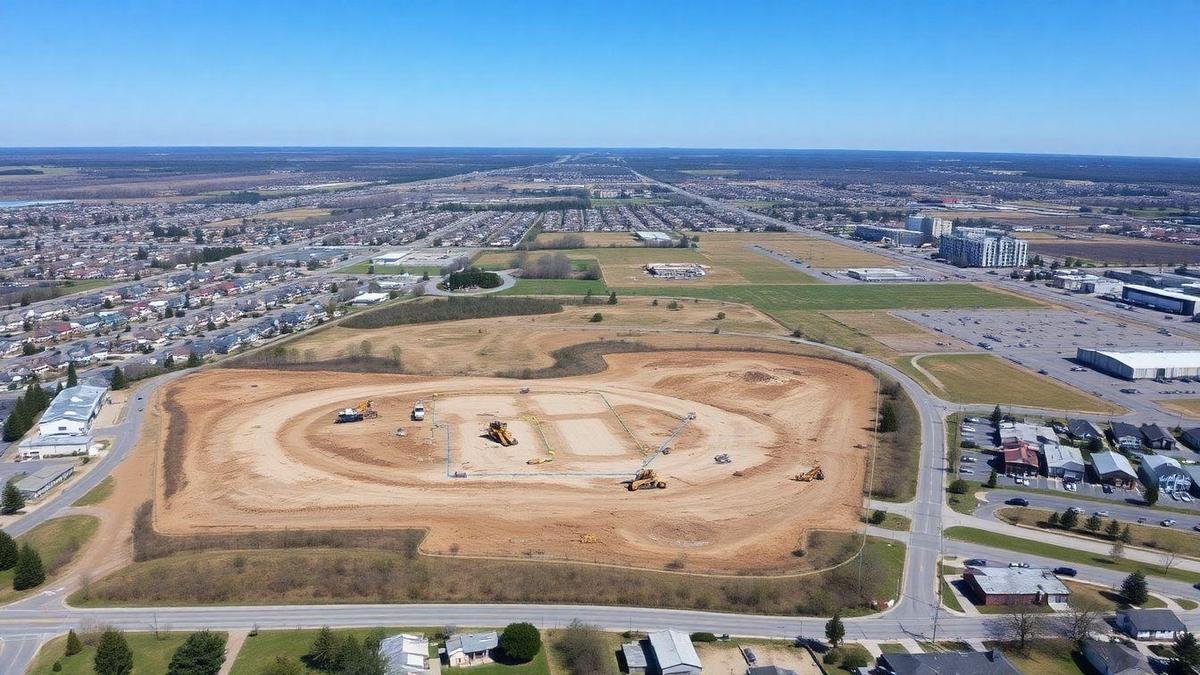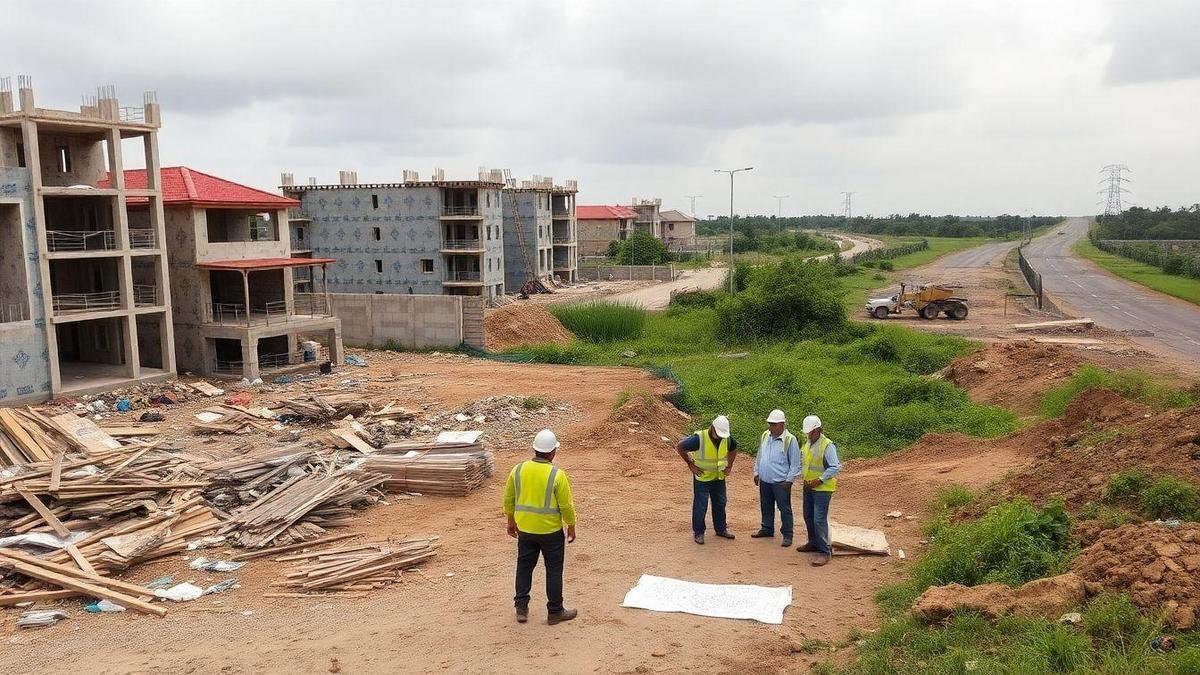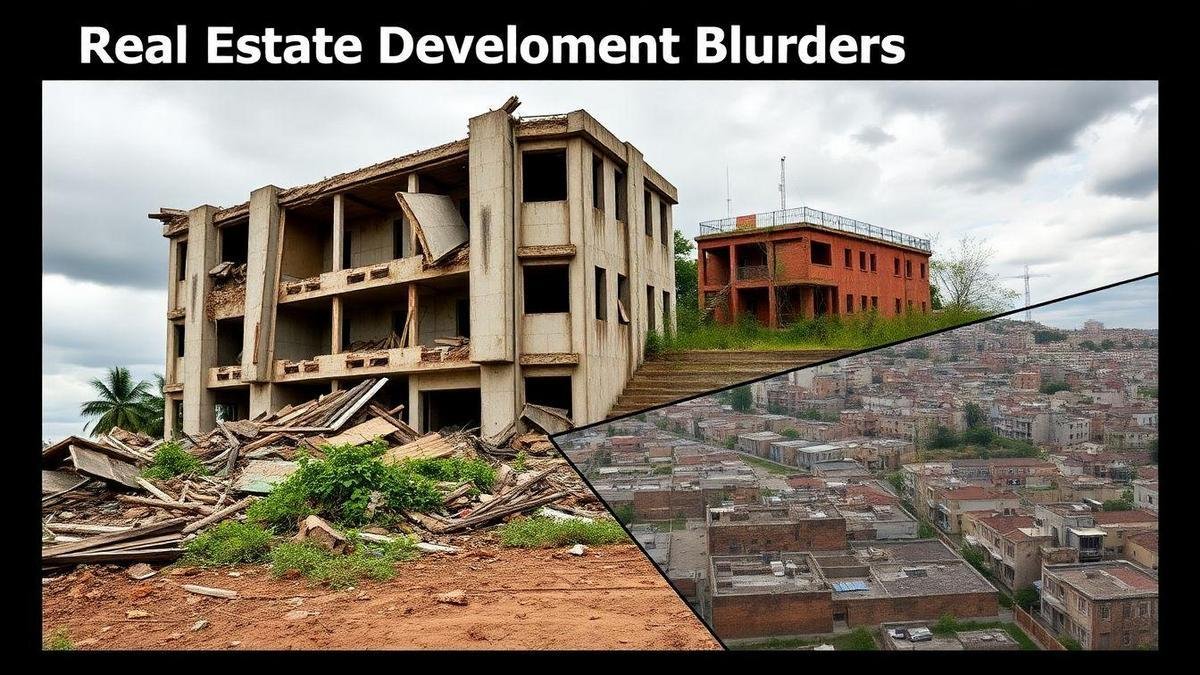Top mistakes in land development can lead to costly issues and project failures. This article explores common pitfalls that developers face, from poor planning to zoning compliance issues. It emphasizes the importance of understanding and avoiding these mistakes. By recognizing potential errors in site selection, environmental assessments, and cost estimations, developers can create better projects. Furthermore, effective project management and meaningful community engagement are crucial for success. Awareness of these elements is key to thriving in land development.
Key Insights
- Poor planning can lead to costly delays.
- Ignoring local laws can cause serious problems.
- Underestimating costs affects the project budget.
- Neglecting community feedback may create resistance.
- Skipping environmental assessments can lead to fines.

Understanding Common Land Development Errors
Identifying Key Land Development Mistakes
In land development, investors often trip over common pitfalls that can derail their projects. Some of the top mistakes in land development include:
- Neglecting Research: Failing to understand local regulations and zoning laws can lead to costly delays. Familiarizing oneself with zoning regulations is essential.
- Poor Site Selection: Choosing a site without considering access to amenities or infrastructure can hinder future growth. Understanding how to start land development can guide better decisions.
- Ignoring Environmental Concerns: Not assessing the environmental impact can result in fines and project halts. A thorough feasibility study can help mitigate these risks.
- Underestimating Costs: Many developers miscalculate budgets, leading to financial strain. Utilizing a cost breakdown can enhance budgeting accuracy.
The Impact of Poor Planning on Projects
Poor planning can have a domino effect on land development projects. When a developer overlooks essential permits, it can cause significant delays, pushing back timelines and increasing costs. A study showed that projects with inadequate planning often exceed budgets by 30% or more.
| Impact of Poor Planning | Consequences |
|---|---|
| Delays | Increased costs |
| Regulatory issues | Legal challenges |
| Environmental fines | Project cancellation |
Why Awareness of Errors Matters
Awareness of these errors is crucial for developers. Recognizing potential pitfalls can save time and money, allowing for smoother project execution. It’s important for investors to learn from past mistakes to avoid repeating them.
By being proactive and informed, they can navigate the complexities of land development with confidence and clarity.

Zoning Compliance Issues in Land Development
Importance of Zoning Regulations
Zoning regulations play a crucial role in land development. They dictate how land can be used, ensuring that properties are developed in ways that are safe and beneficial for the community. These regulations help maintain order and prevent conflicts between different land uses. For instance, a residential area near a factory could lead to noise and pollution issues. By adhering to zoning laws, developers can create spaces that foster community growth and harmony.
Common Zoning Mistakes to Avoid
When diving into land development, there are several common zoning mistakes that developers should steer clear of:
- Ignoring Local Zoning Codes: Each area has specific codes. Not checking these can lead to wasted time and money. Understanding required permits can help avoid pitfalls.
- Underestimating Required Permits: Failing to obtain necessary permits can halt a project.
- Misinterpreting Zoning Classifications: Each classification has its own rules. Misunderstanding these can result in improper development.
- Neglecting to Consult with Experts: Engaging with zoning experts can provide clarity and guidance.
Consequences of Non-Compliance
The consequences of non-compliance with zoning regulations can be severe. They may include:
| Consequence | Description |
|---|---|
| Fines and Penalties | Developers may face hefty fines for violations. |
| Project Delays | Non-compliance can stall projects, leading to delays. |
| Legal Action | Communities may take legal action against developers. |
| Loss of Investment | Financial losses can occur if projects are halted. |
In summary, understanding zoning regulations is essential for successful land development. Making the top mistakes in land development can lead to serious setbacks. Therefore, it is vital for developers to stay informed and compliant.

Site Selection Mistakes to Watch For
Factors Affecting Site Selection
When selecting a site for development, several key factors come into play. These factors can greatly influence the success or failure of a project. Some of the most important ones include:
- Location: Proximity to essential services such as schools, hospitals, and shopping centers can impact the site’s desirability.
- Zoning Regulations: Understanding local zoning laws is crucial. These regulations dictate what can be built and how land can be used.
- Environmental Conditions: Natural features, such as flood zones or protected areas, can complicate development plans. Conducting environmental assessments is critical.
- Market Demand: Knowing the demand for residential or commercial spaces in a given area is vital for making informed decisions.
How Poor Site Choices Affect Development
Making poor site selections can lead to significant setbacks. If a developer chooses a location without considering traffic patterns, they may find that access is limited, making it hard for future tenants or customers to reach their destination. Additionally, sites in areas with low demand can lead to high vacancy rates, ultimately affecting profitability.
Consider a scenario where a developer invests heavily in a site that is not compliant with local zoning laws. This oversight can result in costly delays or even the need to redesign the project entirely, leading to wasted resources. Poor site choices can also lead to community pushback, which can derail projects before they even break ground.
Tips for Better Site Selection
To avoid the top mistakes in land development, developers should consider the following tips:
- Conduct Thorough Research: Understand the area’s demographics, market trends, and local regulations.
- Engage with Local Authorities: Communicating with city planners and zoning boards can provide insights that might not be readily available.
- Analyze Infrastructure: Evaluate the existing infrastructure, including roads, utilities, and public transport options.
- Seek Professional Advice: Hiring experts in land development can provide tailored insights and strategies for site selection.
| Tip | Description |
|---|---|
| Conduct Thorough Research | Gather data on demographics and market trends. |
| Engage with Local Authorities | Communicate with planners for valuable insights. |
| Analyze Infrastructure | Assess roads and utilities for accessibility. |
| Seek Professional Advice | Consult experts for tailored strategies. |

Environmental Assessment Oversights
Role of Environmental Assessments
Environmental assessments play a critical role in land development. They help identify potential impacts on the environment before a project begins. These assessments look at factors like air and water quality, wildlife habitats, and local ecosystems. By evaluating these elements, investors can make informed decisions that align with both regulatory requirements and community expectations.
Common Oversights in Assessments
Despite their importance, many assessments fall short due to common oversights. Here are some frequent mistakes:
- Ignoring Local Regulations: Many developers overlook specific local laws that could affect their project.
- Inadequate Data Collection: Some assessments fail to gather enough data, leading to incomplete evaluations.
- Limited Stakeholder Engagement: Not involving local communities can result in missed insights and opposition later on.
- Failure to Update Assessments: Environmental conditions can change. Failing to revisit assessments can lead to outdated conclusions.
| Common Oversights | Impact on Development |
|---|---|
| Ignoring Local Regulations | Legal complications and project delays |
| Inadequate Data Collection | Misguided decisions and potential harm |
| Limited Stakeholder Engagement | Community backlash and project failure |
| Failure to Update Assessments | Outdated information leading to risks |
Importance of Thorough Evaluations
Thorough evaluations are essential for successful land development. They not only help avoid the top mistakes in land development, but also build trust with stakeholders. When assessments are comprehensive, they provide a clearer picture of potential risks and benefits. This clarity allows investors to navigate challenges effectively and promotes sustainable practices that benefit both the environment and the community.

Cost Estimation Errors in Development Projects
Understanding Cost Estimation Challenges
Cost estimation in development projects can be tricky. Many factors come into play, and even small mistakes can lead to significant issues. One of the top mistakes in land development is underestimating costs. This can happen due to a lack of accurate data or not accounting for unexpected expenses. For instance, if a developer fails to consider the costs of permits or site preparation, they might face financial strain later on.
Another challenge is fluctuating market prices. Prices for materials and labor can change quickly, making it hard to stick to a budget. A developer might plan for a certain price, only to find that it has risen by the time they are ready to buy.
How to Avoid Cost Overruns
To keep costs in check, developers must be proactive. Here are some strategies to help avoid cost overruns:
- Conduct Thorough Research: Gather data on current market rates for materials and labor.
- Include a Contingency Fund: Set aside extra money for unexpected costs. A rule of thumb is to allocate 10-20% of the total budget.
- Use Technology: Software tools can help in creating more accurate estimates and tracking expenses in real-time. Exploring tools for developers can enhance efficiency.
Best Practices for Accurate Estimation
Implementing best practices can lead to more precise cost estimates. Here are some suggestions:
| Best Practice | Description |
|---|---|
| Detailed Breakdown | Break down costs into smaller components for better visibility. |
| Consult Experts | Seek advice from experienced professionals who know the local market. |
| Regular Updates | Review and update estimates regularly to reflect current conditions. |
By following these practices, developers can navigate the complexities of cost estimation more effectively. This approach not only saves money but also enhances project success.

Project Management Failures in Land Development
Key Elements of Successful Project Management
Effective project management in land development hinges on several key elements. These elements act as the backbone for any successful project. They include:
- Clear Objectives: Setting specific goals helps guide the project from start to finish.
- Strong Communication: Keeping all stakeholders informed is crucial for smooth operations.
- Resource Allocation: Properly distributing resources, including time and money, is essential.
- Risk Management: Identifying potential risks early can save time and money later.
| Element | Importance |
|---|---|
| Clear Objectives | Provides direction and purpose |
| Strong Communication | Ensures everyone is on the same page |
| Resource Allocation | Maximizes efficiency and minimizes waste |
| Risk Management | Protects the project from unforeseen challenges |
Recognizing Signs of Project Management Issues
Spotting problems early can prevent a project from spiraling out of control. Some common signs of project management issues include:
- Missed Deadlines: If deadlines are consistently not met, it indicates a lack of planning.
- Budget Overruns: Exceeding the budget suggests poor financial management.
- Poor Team Morale: A disengaged team often points to ineffective leadership.
- Lack of Stakeholder Engagement: If stakeholders are not involved, the project may lack direction.
Strategies for Effective Management
To navigate the top mistakes in land development, employing effective management strategies is vital. Here are a few approaches that can lead to success:
- Regular Check-Ins: Frequent meetings keep everyone aligned and address issues promptly.
- Feedback Loops: Encouraging team members to share their thoughts can enhance project outcomes.
- Flexible Planning: Adapting plans as situations change is crucial in a dynamic environment.
- Training and Development: Investing in team skills can lead to better performance.
By focusing on these strategies, one can significantly improve project management and avoid common pitfalls.

Land Use Planning Mistakes
Importance of Effective Land Use Planning
Effective land use planning is crucial for any successful development project. It allows investors to maximize the potential of their land while minimizing environmental impacts. A well-thought-out plan can lead to better community relations, increased property values, and sustainable growth. Without it, projects may face delays, higher costs, and even legal issues.
Common Pitfalls in Land Use Strategies
Investors often fall into common pitfalls when it comes to land use strategies. Here are some of the top mistakes in land development:
| Mistake | Description |
|---|---|
| Ignoring Local Regulations | Not adhering to zoning laws can lead to fines or project shutdowns. |
| Lack of Community Engagement | Failing to involve local residents can create opposition and distrust. |
| Inadequate Environmental Studies | Overlooking environmental assessments can result in costly remediation. |
| Poor Site Selection | Choosing the wrong location can hinder accessibility and desirability. |
| Insufficient Infrastructure Planning | Neglecting transportation and utilities can stifle development potential. |
How to Improve Land Use Planning
To enhance land use planning, investors should consider the following strategies:
- Conduct Comprehensive Research: Understand local laws, community needs, and environmental impacts.
- Engage with Stakeholders: Actively involve residents, local businesses, and government officials in the planning process.
- Utilize Technology: Use GIS (Geographic Information Systems) to analyze land characteristics and visualize potential developments.
- Develop Flexible Plans: Be prepared to adapt to changes in regulations, market trends, and community feedback.

Real Estate Development Blunders to Avoid
Learning from Past Development Mistakes
In the world of real estate development, many investors have stumbled due to common pitfalls. By examining these past blunders, one can gain valuable insights. For instance, overlooking local zoning laws can lead to costly delays. A developer in a bustling city once launched a project without fully understanding the regulations, resulting in fines that exceeded their budget.
Another frequent mistake is failing to conduct thorough market research. A developer might assume a location is desirable, but without data, they could be left with unsold units. A project in an area with declining population growth serves as a stark reminder of this oversight.
Key Factors Leading to Development Failures
Several key factors often lead to failures in land development. These include:
- Inadequate Planning: Skipping detailed plans can derail projects.
- Ignoring Community Input: Disregarding the needs of the local community can spark opposition.
- Financial Mismanagement: Poor budgeting can lead to project abandonment.
| Factor | Impact | Example |
|---|---|---|
| Inadequate Planning | Project delays and cost overruns | A mall project that missed deadlines |
| Ignoring Community Input | Community backlash and project halting | A housing development faced protests |
| Financial Mismanagement | Project failure due to lack of funds | A developer ran out of cash mid-build |
Strategies for Successful Real Estate Development
To navigate the complexities of real estate development successfully, investors should adopt certain strategies. Here are a few effective approaches:
- Conduct Comprehensive Research: Understand the market and community needs.
- Engage with Local Stakeholders: Involve community members early to gain support.
- Create a Detailed Financial Plan: Budget accurately to avoid running out of funds.
By implementing these strategies, developers can significantly reduce the top mistakes in land development and increase their chances of success.

The Role of Community Engagement in Development
Importance of Engaging Local Communities
Engaging local communities is crucial in land development. When developers involve residents, they gain valuable insights. These insights can help shape projects that reflect the community’s needs and desires. For instance, a park designed with input from local families may include playgrounds and picnic areas that cater to their preferences. This leads to a sense of ownership and pride among residents.
Moreover, involving the community can reduce opposition. When people feel heard, they are more likely to support new developments. This support can lead to smoother project approvals and faster timelines.
Common Mistakes in Community Involvement
Many developers make top mistakes in land development when engaging communities. Here are some common pitfalls:
- Ignoring Local Voices: Failing to listen to community feedback can lead to projects that do not meet local needs.
- Rushed Engagement: Skipping thorough engagement can create misunderstandings and resistance.
- One-Way Communication: Only providing information without inviting feedback can alienate residents.
These mistakes can make projects face hurdles, costing time and resources.
Conclusion
In conclusion, avoiding the top mistakes in land development is essential for ensuring project success and sustainability. By recognizing pitfalls such as poor planning, zoning compliance issues, and cost estimation errors, developers can navigate the complex landscape of land development with greater ease. Engaging with local communities and conducting thorough research not only enhances project viability but also fosters positive relationships with stakeholders. As the old saying goes, “an ounce of prevention is worth a pound of cure.” By being proactive and informed, developers can sidestep costly missteps and pave the way for successful outcomes. For further insights and strategies, readers are encouraged to explore more articles at Land Development Hub.

No responses yet